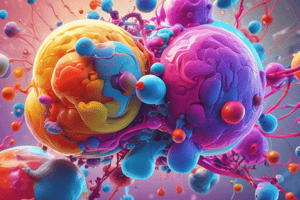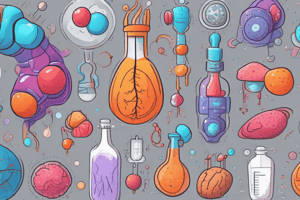Podcast
Questions and Answers
What does metabolism represent?
What does metabolism represent?
- Chemical reactions occurring in body cells (correct)
- Only the synthesis of molecules
- The body's ability to produce heat
- Only the breakdown of food molecules
Which of the following is a catabolic reaction?
Which of the following is a catabolic reaction?
- Synthesis of glucose from lactic acid
- Breakdown of carbohydrates into simpler molecules (correct)
- Formation of fats from free fatty acids
- Synthesis of proteins from amino acids
What is the main energy currency stored during catabolic reactions?
What is the main energy currency stored during catabolic reactions?
- Fatty acids
- ATP (correct)
- Heat energy
- Glucose
Which form of energy is responsible for maintaining body temperature?
Which form of energy is responsible for maintaining body temperature?
An anabolic reaction involves:
An anabolic reaction involves:
What defines metabolic rate?
What defines metabolic rate?
Flashcards are hidden until you start studying
Study Notes
Metabolism
- Chemical reactions within body cells.
- Two main types: catabolic and anabolic.
Catabolic Reactions
- Break down complex food molecules (proteins, fats, carbohydrates).
- Produce simpler molecules and energy:
- Chemical energy (ATP): used for muscle contraction, cellular processes.
- Heat energy: maintains body temperature.
Anabolic Reactions
- Synthesize complex molecules from smaller ones.
- Proteins from amino acids.
- Fats from fatty acids.
- Glucose from lactic acid.
Metabolic Rate
- Amount of heat released per hour during chemical reactions.
- Measured in calories (kilocalories or Calories): heat to raise 1 kg water by 1°C.
- Energy equivalent of O2:
- Carbohydrates: 5 calories/liter O2
- Fat: 4.7 calories/liter O2
- Protein: 4.5 calories/liter O2
- Mixed food: 4.8 calories/liter O2
Measuring Metabolic Rate
- Direct Calorimetry: measures heat lost by a subject in a calorimeter.
- Indirect Calorimetry: calculates heat produced from O2 consumption (MR = O2 utilized (liters/hour) × 4.8).
Energy Balance
- In healthy adults, energy intake equals energy output.
- Energy output includes:
- Internal work: metabolic functions, digestion, temperature regulation.
- External work: physical activity.
Specific Dynamic Action of Food (SDA) / Thermal Effect of Food (TEF)
- Energy used to digest, absorb, and metabolize food.
- Contributes to daily calorie expenditure.
- Starts one hour after eating, lasts 4-12 hours.
- Factors affecting TEF: age (decreases with age), physical activity (increases TEF), meal size, composition, frequency, processing, and external temperature.
- Proteins have the highest TEF.
- TEF is directly proportional to food intake.
- TEF decreases at low temperatures and increases at high temperatures.
Total Energy Expenditure
- Includes internal and external work plus TEF.
Studying That Suits You
Use AI to generate personalized quizzes and flashcards to suit your learning preferences.




